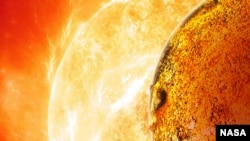Two teams of astronomers have, for the first time, measured an Earth-sized exoplanet, a planet they say should not exist.
But the planet, known as Kepler-78b, is not likely to support any kind of life as we know it. The temperatures on the planet would be scorching as it circles its star every eight-and-a-half hours at a distance of less than one million miles – one of the tightest known orbits. The orbit is 40 times closer than Mercury’s, for example.
Temperatures on the surface would likely reach an infernal 2,000 to 2,800 Celsius.
Astronomer Francesco Pepe of the University of Geneva in Switzerland, who led one of the teams, said the planet can be “imagined like a lava planet rather than an Earth-like planet.”
The planet, which is 400 light-years from Earth in the constellation Cygnus, has a similar mass to Earth, leading astronomers to believe that it has a similar make up of iron and rock. Kepler-78b is 20 percent larger than Earth and weighs about twice as much, meaning it’s likely to have a similar density.
According to current theories of planet formation, it couldn’t have formed so close to its star, nor could it have moved there.
Because it’s so close to its star, Kepler-78, the planet is doomed, astronomers say. Gravitational tides will continue to draw it even closer to its star. Eventually, it will move so close that the star’s gravity will rip the world apart.
Theorists predict the planet will vanish within three billion years. Our solar system could have held a planet like Kepler-78b. If it had, the planet would have been destroyed long ago leaving no signs for astronomers today.
Astronomers were able to measure the planet’s orbit and size by studying the light from its star as the planet transits, or passes in front of the star. Each time the planet passes, there is a small decrease in the amount of light from the star. Measuring this decrease can determine the planet’s size.
Measuring the mass of an exoplanet involves measuring the slight wobble the planet’s gravity causes on its star as it orbits.
The results from two independent teams were published in the journal Nature on Wednesday.
Sara Seager, a planetary scientist at the Massachusetts Institute of Technology (MIT) in Cambridge, Massachusetts, who was not part of either team, told Nature that the results represented “an inevitable march towards other Earths.”
But the planet, known as Kepler-78b, is not likely to support any kind of life as we know it. The temperatures on the planet would be scorching as it circles its star every eight-and-a-half hours at a distance of less than one million miles – one of the tightest known orbits. The orbit is 40 times closer than Mercury’s, for example.
Temperatures on the surface would likely reach an infernal 2,000 to 2,800 Celsius.
Astronomer Francesco Pepe of the University of Geneva in Switzerland, who led one of the teams, said the planet can be “imagined like a lava planet rather than an Earth-like planet.”
The planet, which is 400 light-years from Earth in the constellation Cygnus, has a similar mass to Earth, leading astronomers to believe that it has a similar make up of iron and rock. Kepler-78b is 20 percent larger than Earth and weighs about twice as much, meaning it’s likely to have a similar density.
According to current theories of planet formation, it couldn’t have formed so close to its star, nor could it have moved there.
Because it’s so close to its star, Kepler-78, the planet is doomed, astronomers say. Gravitational tides will continue to draw it even closer to its star. Eventually, it will move so close that the star’s gravity will rip the world apart.
Theorists predict the planet will vanish within three billion years. Our solar system could have held a planet like Kepler-78b. If it had, the planet would have been destroyed long ago leaving no signs for astronomers today.
Astronomers were able to measure the planet’s orbit and size by studying the light from its star as the planet transits, or passes in front of the star. Each time the planet passes, there is a small decrease in the amount of light from the star. Measuring this decrease can determine the planet’s size.
Measuring the mass of an exoplanet involves measuring the slight wobble the planet’s gravity causes on its star as it orbits.
The results from two independent teams were published in the journal Nature on Wednesday.
Sara Seager, a planetary scientist at the Massachusetts Institute of Technology (MIT) in Cambridge, Massachusetts, who was not part of either team, told Nature that the results represented “an inevitable march towards other Earths.”









